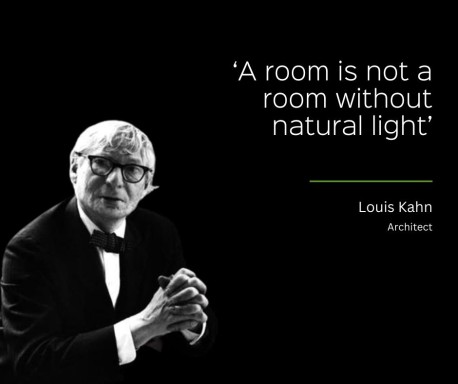Posted on: 19 - 6 - 2023
5 benefits of natural light in an office
Office workers will spend approximately 90,000 hours of their lives in an office. 40% of office workers in New Zealand and Australia, who were surveyed by OSIN, stated that they strongly felt they did not receive sufficient natural daylight. 90% advised that they spent less than 1 hour outside per day. Hard to fathom, but the statistics do not lie. It is safe to say we do not go to work anticipating the hours we will spend under LED lighting and lacking the quality of light we need to work efficiently and function as human beings.
When Architects and designers are tasked to light workplaces, natural light remains the first choice. However, in architecture and building design, there will always be spaces created where natural light cannot penetrate, and as a result, purposeful artificial light will step in to complement. Standard LED luminaries remain functional to support basic visual needs but remain inadequate in supporting our biology.
The latter can be tackled by advancing technology in the world of circadian lighting. Sky blue LED technology in artificial light sources is seeing steady growth as more and more building owners and clients opt for integrated lighting design, whereby Sky blue technology can provide the spectrum needed by people, in places where natural light cannot reach them.
The LED was invented in 1962. LED luminaries have seen a rise to prominence in the last 10 years to quench the thirst of energy efficiency. Unfortunately, the LED lighting movement missed an opportunity to deliver benefits for our biology, as the focus on vision was always the goal for mainstream LED technology, a metric based on scientific research from 1924, almost 100 years ago.
In 2023, this lighting is considered highly inadequate for our well-being and for our circadian rhythm therefore alternatives need to be introduced.
 Louis Kahn, the Estonian-born American architect, once said: "a room is not a room without natural light." Much like his philosophy of designing spaces that not only tell the story of the construction, he strongly believed that it should simultaneously meet the function and aesthetic of the people who inhabit it.
Louis Kahn, the Estonian-born American architect, once said: "a room is not a room without natural light." Much like his philosophy of designing spaces that not only tell the story of the construction, he strongly believed that it should simultaneously meet the function and aesthetic of the people who inhabit it.
A push towards biophilia, increased natural light, circadian lighting and re-designing office layout all play a part in improving the day-to-day lives of workers whilst they are in the care of employers.
As architects and lighting designers, the industry must continuously work towards creating functional offices and spaces that meet the needs of those who are affected. Standard 4000K LED is no longer the answer.
Below we look at 5 benefits of natural light in an office and how they may be achieved:
1. Share the Sun - Lighting in commercial buildings is responsible for 38% of electricity consumption. Simply improving the distribution of natural sunlight in an office can reduce the dependence on artificial light sources.
KEY POINT 1: reevaluate the location of desks and work pods. How can they better be positioned, so everyone can access natural light within the space? Are desks just stationed where they have been for the last 5 years? Can they be moved?
2. Encourage Outside Breaks - Encourage employees to take a break from their computers and head outside, whether for a brisk walk, or simply a coffee in the sun; every ounce of sunlight is beneficial for them.
KEY POINT 2: understandably not all employees will take this on; however professions where leaving the desk is impossible, it may be of benefit for circadian lighting to be implemented; therefore workers who are unable to leave the office are still benefiting in the long run.
3. Workers Are Healthier - this may be subjective to other factors, but many studies such as a 2011 study at the Univeristy of Oregon confirmed that exposure to natural light is interconnected with the amount of sick time employees take. In the study, those with nice views of the outside and who received a decent amount of sunlight took 6.5 percent less sick leave than others.
KEY POINT 3: Meagre lighting can play a part in acute circadian disruption (loss of attention, daytime sleepiness, cognitive impairment etc), if untreated these can lead to chronic conditions such as depression, anxiety and in extreme cases cancer. Workplace lighting is one of the key facilities that can pose a health risk to employees if they are not adequately managed. In New Zealand, WorkSafe have stated that employees must be kept abreast of any facility changes if they are to affect their health and safety.
4. Improved Circadian Rhythm - Exposure to ample natural light during the day allows workers to receive vitamin D and melanopsin which aid in circadian entrainment and reduce fatigue, headaches, and their overall sleep cycle.
KEY POINT 4: quality light improves the condition of worker's sleep, allowing them to come to work refreshed and productive. As opposed to suffering circadian misalignment and enduring negative consequences such as lack of performance, loss of attention and daytime sleepiness.
5. Increases The Monetary Value Of The Building - Offices with ample natural lighting are incredibly more appealing to potential tenants than those consumed by inadequate light sources. Leases can increase as much as $4 per square foot more than those buildings that are light deficient.
KEY POINT 5: Think of the spaces you are creating or developing and the people that will be in them. Natural light is key, however if this is impossible (such as in basement offices) using circadian lighting is a technologically forward lighting system that can make all the difference to your bottom line.
(*source: hammerandhand.com, newdayoffice.com, prnewswire.com, worksafe.govt.nz)
Back to Blog